
New technologies in the completions sector have helped drive down costs for operations, allowing companies to be more profitable. (Source: Junrong, Shutterstock.com)
Different companies call their oil production efforts by different names. Sometimes they even adopt catchy monikers to label programs that all essentially mean the same thing—do more with less, and do it well enough to make a profit amid market conditions. In the fight-or-flight world of sub-$60 oil, companies choosing to stay and fight are finding that to do so they need to determine more economical ways of producing enough oil and gas to remain profitable.
The results indicate that shale operators are doing just that. Breakevens are down, way down, to $46/bbl in the Permian Basin, $48/bbl in the Eagle Ford and $47/ bbl in the SCOOP/STACK. According to the Federal Reserve Bank of Dallas, some operators in the Midland Basin are reporting breakevens at $25/bbl.
Of course, streamlined operations play a significant role in this trend of lower breakevens. But so too does the bounty of new technologies, tools and systems developed by the vast range of service industry innovators. If the evolution of humanity’s technological capabilities can be categorized as they have—The Stone Age, The Industrial Revolution, The Information Age—so too can the energy industry’s. Decades from now one might look back at the time most are calling a prolonged price recession and realize what it really was— the oil and gas industry’s own “age of innovation.”
Detailed in the following pages are some of the companies and innovations that are helping to play a role in an industry environment in which the U.S. is racing past some of the world’s traditional oil-producing powerhouses.
New tools and systems in the completions field are just one component to the overall cycle of producing a barrel of oil. But they are among the most important. Which of these profiled here could push breakevens even lower?
Editor’s note: The copy herein is contributed from service companies and does not reflect the opinions of Hart Energy.
 SYSTEM HELPS DETERMINE FRICTION PRESSURE CHANGES
SYSTEM HELPS DETERMINE FRICTION PRESSURE CHANGES
The Model 6500 Friction Flow Loop from AMETEK Chandler Engineering is a fully automated system that measures the friction pressure created by different wellbore fluids. The system is designed to study the effect different friction reducers have on fracturing, acidizing, completion and drilling fluids over a range of pressures, flow-rate conditions and pipe diameters. The Model 6500 circulates fluid through two test sections of various diameters to generate differential pressure vs. flow-rate data. These data are then used to determine the effectiveness and longevity of various friction-reducing agents added to the test fluids. The Model 6500 incorporates a low-shear progressive cavity pump for injection of base fluids, with the flow rate controlled by a Coriolis flowmeter. High-accuracy differential pressure transducers are provided for each tubing diameter for multiple data readings per test. Fluid can be injected into the flowstream via an optional metering pump or added directly into a 15-gal reservoir mixing tank. chandlereng.com
NEW COATING APPLICATION ENHANCES SILICA DUST CONTROL
Silica dust emissions from hydraulic fracturing remain an ongoing concern for the industry. ArrMaz collaborated with industry experts, applied 50-plus years of coating expertise and adapted a coating application system to develop an effective technology for silica dust control. SandTec, ArrMaz’s patented next-generation silica dust control proppant coating technology, reduces respirable silica dust by up to 99% to within the Occupational Safety and Health Administration’s new permissible exposure limit and action level. When applied to fracture sand, SandTec provides continuous silica dust protection across the hydraulic fracturing supply chain. The technology provides continuous protection from sand plant to wellhead, and it simplifies and fast-tracks fracture sand logistics. SandTec also offers ease of application without drying or curing and compatibility with a variety of fracture fluids while not adversely affecting well performance or occupying valuable fracture site real estate. With this technology there is no need for setup, tear-down or maintenance of mechanical dust control systems. SandTec offers reduction of site dust that can adversely affect equipment, and it is an environmentally friendly U.S. Department of Agriculture-certified 100% biobased product under the BioPreferred program. arrmaz.com/ep

Untreated fracturing sand (left) compared to fracturing sand treated with SandTec (right) shows improved dust control. (Source: ArrMaz)
 COMPOSITE FRACTURE PLUG IMPROVES PNP SPEED, RELIABILITY
COMPOSITE FRACTURE PLUG IMPROVES PNP SPEED, RELIABILITY
Plug-and-perf (PNP) completions favored among unconventional operators are process-intensive. Composite plug drillouts can take days, and the plugs can become stuck in the wellbore or set prematurely, resulting in unplanned interventions. Baker Hughes’ TORPEDO composite fracture plugs deliver a new level of efficiency and reliability in PNP operations using a streamlined design that is also more robust than competitive offerings. The plug, which features a single set of slips vs. the conventional two sets, contains 40% less material and is shorter in length compared to standard plug designs. The plug cuts millout times by an average of 50% without sacrificing strength or reliability. The plug also incorporates an ultradurable slip ring and contains no ceramic or carbide buttons to reduce the risk of sticking and plug presets. An Oklahoma operator recently ran 33 TORPEDO composite plugs in a 4,572-m (15,000-ft) well with a 3,048-m (10,000-ft) lateral section at an average rate of 122 m/min (400 ft/min)—almost double the average run-in speed for standard plugs in previous jobs. No sticking or presets resulted in zero plug-related nonproductive time during well completion. Drill-out time was cut by 80%, from 15 to 3 minutes per plug, and all plugs were drilled out in a single trip using a Baker Hughes VANGUARD drillbit. The smaller overall volume of cuttings enabled easier, more effective wellbore cleanup. bakerhughes.com
 SYSTEM IMPROVES ABILITY TO DETECT LOCATION OF PROPPANTS IN RESERVOIR
SYSTEM IMPROVES ABILITY TO DETECT LOCATION OF PROPPANTS IN RESERVOIR
About 100 billion pounds mass of proppant is used annually in global unconventional reservoirs, with the location of the proppant critical to understanding reservoir drainage, well spacing and stage spacing. However, proppant detection has traditionally been limited to near-wellbore measurements. CARBO has developed a method to detect proppant in the far field, known as QUANTUM quantified propped reservoir volume imaging. The QUANTUM method, now in the field trial phase, uses electromagnetic principles. A transmitter source and an array of electric and magnetic field sensors are located at the surface, and a current signal with a unique wave form and frequency is transmitted to the bottom of the wellbore via a standard electric line unit. An electrically conductive proppant is pumped into the stages of interest. The electric and magnetic fields are measured before and after the detectable proppant stages, and a novel analysis method is then employed to process and invert these differenced data to create an image of the propped reservoir volume. QUANTUM is designed to identify the exact location of proppant in fractures. The program also assists in understanding well drainage and spacing, stage and perforation cluster spacing, vertical fracture coverage, and the impact of fracture design changes. carboceramics.com
 NEW REAMER SHOE HELPS RUN CASING TO TOTAL DEPTH
NEW REAMER SHOE HELPS RUN CASING TO TOTAL DEPTH
Downhole Products (DHP) has released Reaper, an aggressive reamer shoe with an integrated polycrystalline diamond composite (PDC) cutting structure. Building off the Pen-O-Trator design, Reaper features a wellbore-seeking eccentric guide nose to negotiate troublesome formations, anti-aggressive left-hand blades to minimize torque, a PDC millable nose for drillout and a casing-friendly tungsten carbide cutting structure on the body. Reaper has been designed specifically for use in applications where hole wall quality is a concern for getting casing run to total depth. Shale formations pose several challenges for effective casing running because they are prone to swelling, sloughing, ledging and formation shifts—all of which leave casing stuck or wear out traditional casing shoes. To combat these problems, DHP has enhanced the alloy compound of the nose, providing improved wear and erosion resistance. The Reaper also features three rows of PDC cutters along the nose for a true cutting structure to remove formation as needed while casing is run to bottom. downhole.org
 EXPANDABLE LINERS LEAD TO PRECISE REFRACTURING APPLICATIONS
EXPANDABLE LINERS LEAD TO PRECISE REFRACTURING APPLICATIONS
Operators are taking advantage of improved fracturing designs to increase production and EURs of mature and largely impermeable shale wells. Various mechanical and chemical refracturing techniques have been employed with mixed results. For example, sealing off older unproductive perforations with particulates is unpredictable, unreliable and requires multiple attempts. Even then, sustained integrity remains a question. Chemical diverting agents lack internal pressure integrity and tend to follow the path of least resistance. These limitations led Enventure to develop the expandable refracturing liner. The liner provides a new wellbore with zonal isolation of existing perforations and internal pressure integrity that enables greater predictability of planned fracture stages. This method translates into a faster payback on investment and extended production life. The ESeal RF Liner increased flow area by 47% compared to the conventional recompletion option. Ten expandable seals placed along the liner ensured accurate isolation of old perforations, enabling the operator to effectively apply lessons learned for an optimal refracturing program with a new wellbore. Surface pressures during the refracture were identical to those during the initial fracture, indicating that the ESeal RF Liner enabled the operator to fracture into a new, untouched reservoir. enventuregt.com
 FULLY ELECTRIC FRACTURE FLEET COULD LEAD TO COST SAVINGS
FULLY ELECTRIC FRACTURE FLEET COULD LEAD TO COST SAVINGS
In today’s era of pushing for high efficiencies and enhanced economics in shale formations while also being conscious of environmental concerns, little or no options exist in the hydraulic fracturing market. Evolution Well Services provides the ability to reduce overall annualized fracturing costs by up to $30 million per fleet, lower emissions to well below Environmental Protection Agency Tier IV standards, implement a 67% reduction in pump trailer footprint and reduce noise levels to 82 dB. This is accomplished by powering the 48,000- hhp fracture fleet with 100% electricity from a single natural gas-burning turbine. This power density allows overall pad footprint, including all ancillary equipment, to be reduced by 46%. Evolution’s multipatented fleets are also much safer and eliminate the need for “hot fueling.” evolutionws.com
PROPPANT TECH ENHANCES WATER SOURCE FOR FRACTURING COMPATIBILITY
Expansion in hydraulic fracturing has created an industrywide water management concern, both in the sourcing of freshwater and produced water disposal. The growth of stimulation programs is putting oil and gas in competition for potable water with other industries and municipalities. A formulation of self-suspending proppant (SSP) approaches this challenge by correcting the water source to make it compatible with fracturing fluid systems. This SSP technology serves as a proppant coating that adapts to produced water with minimal to no pretreatment. It also relies on a hydrogel coating atop raw sand or ceramics that hydrates in water with measured total dissolved solids up to 350,000 parts per million (ppm) and hardness up to 40,000 ppm. The hydrated coating reduces the effective density of the proppant, decreasing proppant settling and creating greater stacked height of the proppant in the fracture. Since the coating is bonded to the individual proppant particle and does not crosslink or significantly viscosify the carrying fluid, the resulting fracture fluid system exhibits exceptionally low frictional pressure even at high proppant loading rates. This technology allows an operator to pump a slickwater-like fracture program with low-quality water while still achieving proppant loading rates that can range from 0.25 pound of proppant added (ppa) to 12 ppa—all without damaging the formation or proppant pack itself. Propel SSP couples improved proppant transport to environmental stewardship, allowing companies to mitigate risks to their operation while simultaneously building better wells. fairmountsantrol.com

Propel SSP swells and self-suspends when faced with fresh, brackish or even produced water. (Source: Fairmount Santrol)
 DIESEL, NATURAL GAS-OPERATED FUELING UNIT ENHANCES FRACTURING EFFICIENCIES
DIESEL, NATURAL GAS-OPERATED FUELING UNIT ENHANCES FRACTURING EFFICIENCIES
Frac Shack International Inc. recently released the world’s first combined diesel and natural gas automated fueling unit for hydraulic fracturing operations. The 16-m (53-ft) mobile trailer unit allows operators to safely and efficiently fuel fracture spreads with both diesel and natural gas as well as increase the accuracy of their analysis with modernized line and consumption data. The mobile unit features 12 natural gas lines and 12 diesel lines and includes its own 7,900-gal diesel tank. Frac Shack’s Bi-Fuel Distribution Unit is compatible with LNG, CNG, field gas and pipeline gas. The Bi-Fuel Frac Shack ensures equal, consistent and measurable pressure to each individual pumper, so both fracture service companies and end users can be confident they are achieving the best substitution rate possible. Significant time savings are achieved with no disassembly or depressurizing required. The quick-connect gas connections ensure switching out pumpers is fast and efficient. The combined diesel/natural gas supply reduces costs and traffic on locations by removing the need to have fuel trucks onsite at all times. fracshack.com
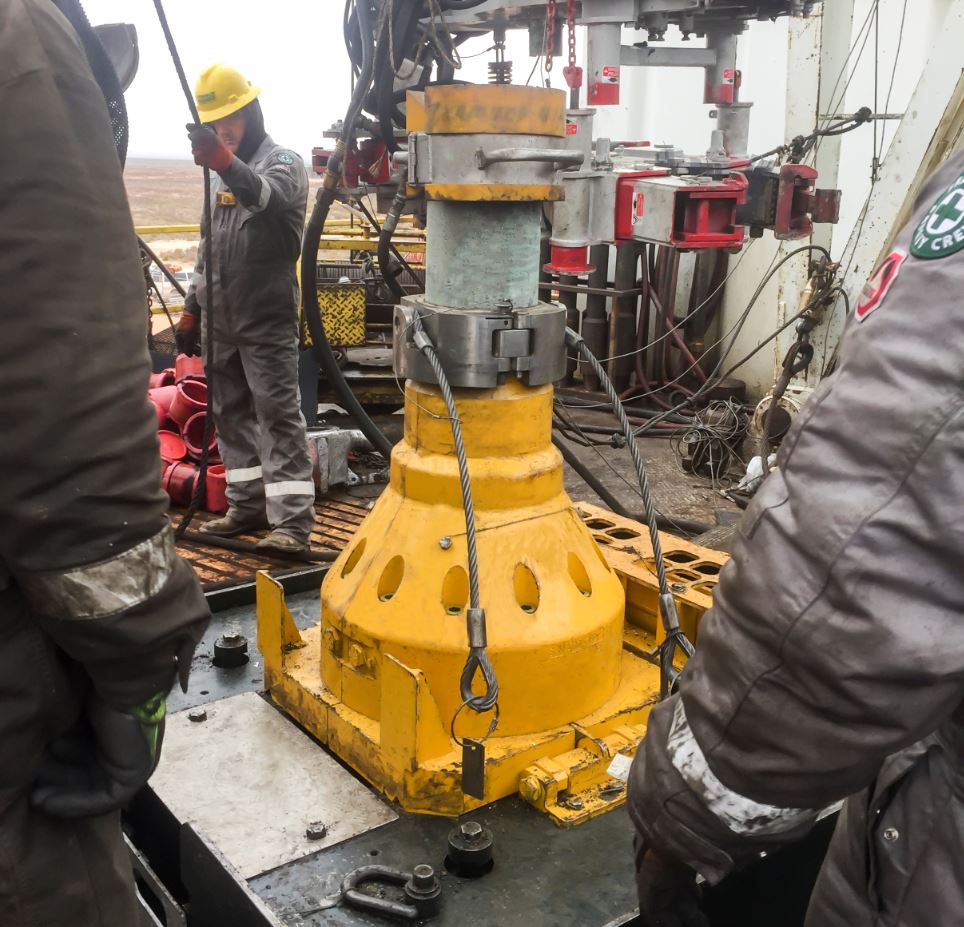 TUBULAR HANDLING SYSTEM HELPS ELIMINATE CORROSION AND STRESS CRACKING
TUBULAR HANDLING SYSTEM HELPS ELIMINATE CORROSION AND STRESS CRACKING
In addition to the natural generation of H2S through oil and gas upstream production, the anthropogenic processes (e.g., hydraulic fracturing) used to extract hydrocarbons from shale formations release substantial volumes of H2S during production. The vast presence of this toxic gas in regions particularly fraught with sour gas reserves jeopardizes well integrity via tubular corrosion. As a result, corrosion-resistant alloys (CRAs) often are required in such regions to mitigate sour gas-induced damages. Gripping inserts or dies common to most types of tubular handling equipment, however, leave impressions on pipe—including CRAs—that, in sour wells, increase downhole tubular susceptibility to corrosion and sulfide stress cracking. Frank’s International has released its next-generation 27½-in. Collar Load Support technology as a solution. The fully nonmarking handling system features an above-the-rotary shock table with the ability to interface rotaries of 27½-in. or smaller, which is ideal for land rigs. With improved roll and pitch stability, the 250-ton-rated shock table provides optimum support of the tubular string over the entire coupling load-face as well as ample load capacity for land operations. franksinternational.com
 TOOL’S USES INCLUDE REAMING, TUBULAR DEPLOYMENT AND CASE SCRAPING
TOOL’S USES INCLUDE REAMING, TUBULAR DEPLOYMENT AND CASE SCRAPING
Geopro’s HYDRA family of tools provides a variety of functions in the life of a well. This system can be configured and run as a high-speed reaming solution for casing or tubular deployment or used as a casing scraper with integrated wire brush. The system also can be used as a jetting tool for wellbore cleanup operations. With rotary speeds in excess of 1,500 rpm, the HYDRA is an ideal candidate for casing and liner cementing operations since the fluid pattern created at the shoe ensures better mud condition is achieved and should minimize cement/mud contamination during cementing. The HYDRA is designed to replace standard cementing and guide shoes by combining their respective features, extending their possible application. When the pumps are on, the circulated fluid is channeled through the central spline of the HYDRA tool and then forced through grooves in the inner sleeve via a set of impellers. This process results in high rotational speeds, low pressure drop and low torque, making this a natural fit for high-angle horizontal well cementing operations. The HYDRA has a low-torque high-speed casing/ cementing/reamer shoe that provides sufficient torque to get through slight obstructions in the borehole such as cuttings beds, debris and slight tight hole conditions. The tool also has a multijet nozzle configuration with a center jet that ensures radial deposition of fluids as well as a limited downward jet, which reduces contamination between fluids when displacing cementing. The center jets can be blanked off to concentrate fluid direction toward the borehole walls. This is relevant for cuttings beds agitation and shale breakouts. geoprotech.com
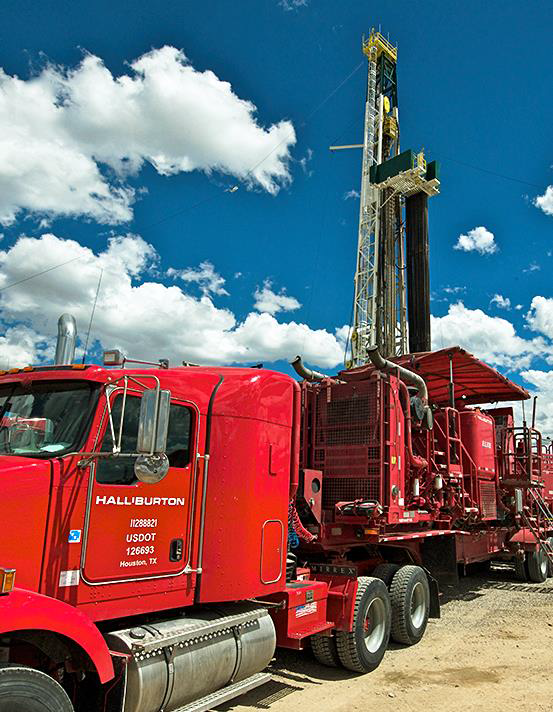 NEW CEMENT SYSTEM OFFERS ENHANCED MECHANICAL PROPERTIES, LOWER DENSITY
NEW CEMENT SYSTEM OFFERS ENHANCED MECHANICAL PROPERTIES, LOWER DENSITY
NeoCem cement is a low-Portland cement system designed to deliver better mechanical properties at a lower density than conventional cement systems. This technology is the result of Halliburton’s R&D team discovering physicochemical synergies between specialized materials and Portland cement. The improved mechanical properties can include increased ductility for better resistance to cyclical stress loading during fracturing stages; increased “strain to failure,” improving robustness for the life of the well; and improved compressive and tensile strengths at given density. NeoCem cement has demonstrated more than 10% improvement in compressive strength and up to a 15% improvement in elasticity compared to a conventional cement system with greater than a 1-parts-per-gallon higher density. This combination of enhancements results in a compressive strength to Young’s modulus ratio that can be 30% higher than the higher density conventional cement systems. NeoCem cement enables lighter weight cement systems with easier and improved mechanical properties without increasing cost to the customer or requiring additional rigsite equipment. This new product was commercially introduced in early 2016, and to date more than 1 MMbbl have been pumped for more than 90 customers. halliburton.com
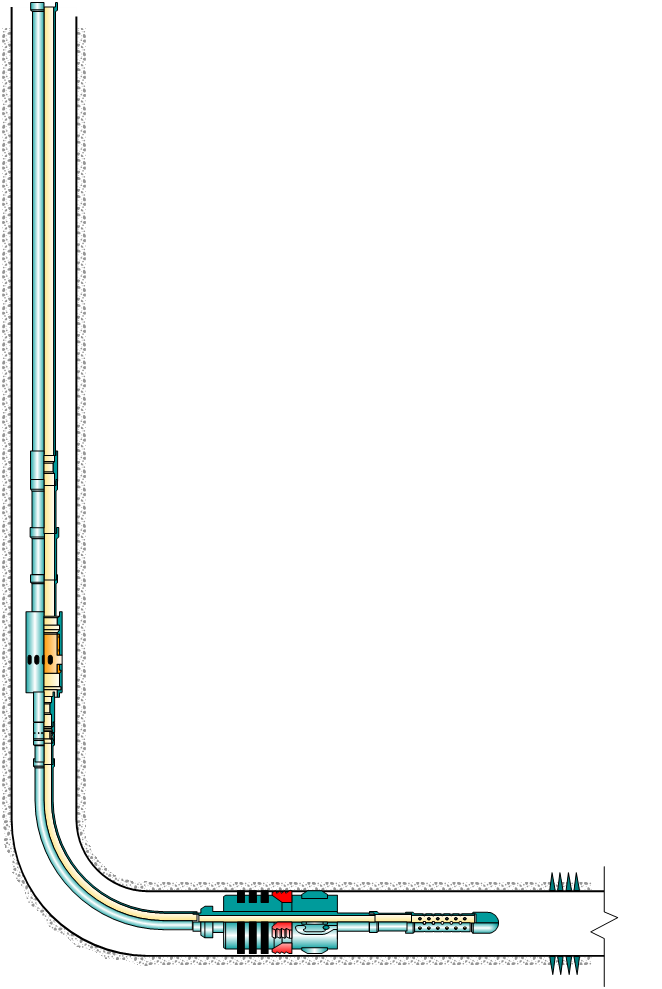 ARTIFICIAL LIFT SLICKLINE SYSTEM PROTECTS AGAINST FRACTURE HITS
ARTIFICIAL LIFT SLICKLINE SYSTEM PROTECTS AGAINST FRACTURE HITS
For oil and gas producers in active shale fields, fracture hits are a growing concern. A fracture hit occurs when an offset well is fractured and the fracture communicates with another producing wellbore. A fracture hit can cause the well to fill with fracture sand, resulting in productivity losses. The impact can result in severe damage to the artificial lift system and possibly a well control event with excessive pressures at surface. HEAL Systems’ Horizontal Enhanced Artificial Lift, or HEAL Slickline System, offers economical fracture hit protection with greater access to the wellbore and easy installation. The HEAL Slickline System incorporates a retrievable separator prong that is replaced with a deep barrier to protect the wellbore from the consequences of a fracture hit. Before the offset well is fractured, a slickline unit pulls the HEAL separator prong and installs a standard profile blanking plug. After offset well fracture operations are complete, the blanking plug is removed and the well is put back on production. Without the HEAL Slickline System, operators often pull the full artificial lift system and production string to run a deep bridge plug. With the HEAL Slickline System all operations are performed with the production tubing left in place, significantly reducing cost over the conventional solution. healsystems.com
 RESIN-COATED PROPPANTS INCREASE LONG-TERM PRODUCTION
RESIN-COATED PROPPANTS INCREASE LONG-TERM PRODUCTION
Hexion’s advanced resin-coated proppant technology helps operators improve their well economics. Most completed wells use uncoated fracturing sand—often regardless of the downhole conditions—in an effort to reduce cost. The IPs of these wells look very promising. However, as the uncoated fracturing sands are continuously subjected to downhole pressure, temperature and moisture, they might begin to crush. This can impact fracture conductivity within the first few months. Uncoated fracture sand is less expensive initially compared to resin-coated sand. However, once these proppants begin to fail, well production begins to decline. Resin-coated proppants have been found to withstand downhole conditions such as high-closure stress and cyclic stress changes, resulting in improved long-term hydrocarbon production. Production data studies continue to prove that uncoated fracturing sand, particularly in deeper wells, leads to production declines far steeper than resin-coated proppants. A recent example is in the Permian Basin, where offset wells were used with similar conditions. Hexion’s OilPlus proppants outperformed uncoated fracturing sand with a 49% increase in production over 12 months. hexion.com
NEW BIODEGRADABLE FRACTURING SLEEVE BALLS, PLUGS DISSOLVE FASTER
Operators have struggled with biodegradable frack sleeve balls and plugs as they can take several days or weeks to dissolve. Locus Bio-Energy Solutions LLC has developed a microbial solution that dissolves polyactic acid polymer and dissolvable packers much more quickly—in hours rather than days—at a wide range of temperatures. This allows much quicker production ramps and revenue generation. Locus also is working on hydraulic fracturing/ completion solutions such as in situ biosurfactant production, fracture damage repair and biopolymer utilization for carrier fluids. These solutions support the trend toward increasing lateral lengths that are otherwise constrained by coiled tubing limitations (see figure). For example, Locus’ biodegradable biosurfactant flowback solution can efficiently decrease water surface tension to the desired 28 to 30 dynes/ cm range. locusbioenergy.com

Locus’ hydraulic fracturing/completions solutions often result in longer lateral lengths. (Source: Locus Bio-Energy Solutions)
 DISSOLVABLE ALLOYS OFFER FLEXIBILITY IN SLIDING SLEEVE, PNP OPERATIONS
DISSOLVABLE ALLOYS OFFER FLEXIBILITY IN SLIDING SLEEVE, PNP OPERATIONS
Magnesium Elektron offers SoluMag dissolving magnesium alloys, which encompass a wide range of material properties for highstrength or high-ductility applications as well as controlled dissolution performance in salt solutions or freshwater. SoluMag alloys are being used in sliding sleeve and plug-and-perf (PNP) applications as fracturing balls and for dissolving fracturing plug components in North American oil and gas wells. The wide range of SoluMag dissolving magnesium alloys was developed to give the designer, service company or operator the confidence that the material will work in downhole conditions predictably and reliably. Using SoluMag lowers the risk of uncorroded magnesium returning to surface. Giving the user the data as to how this material performs in the wide range of operating conditions will allow the completion to go smoothly without intervention. magnesium-elektron.com
 NEW RESIN OFFERS MORE THAN 20,000 PSI OF STRENGTH
NEW RESIN OFFERS MORE THAN 20,000 PSI OF STRENGTH
Materia Inc., a producer of high-performance polymers, offers a new nonmetallic composite material for inner-string cementing equipment. Proxima HPR 2029 is a new high-strength grade of thermosetting resin for replacing aluminum in plugs, valves, noses and housings. The product offers more than 20,000 psi of strength as well as temperature ratings that exceed 204 C (400 F). The material is easy to machine and drills out up to 20 times faster than aluminum, delivering several hours of rig time cost savings. Like the other products in Materia’s Proxima HPR product line, Proxima HPR 2029 is easy to mold using low-cost equipment in high throughput. The new high-strength grade of thermosetting resin complements Materia’s product line of low drag and wear-resistant polymers. materia-inc.com
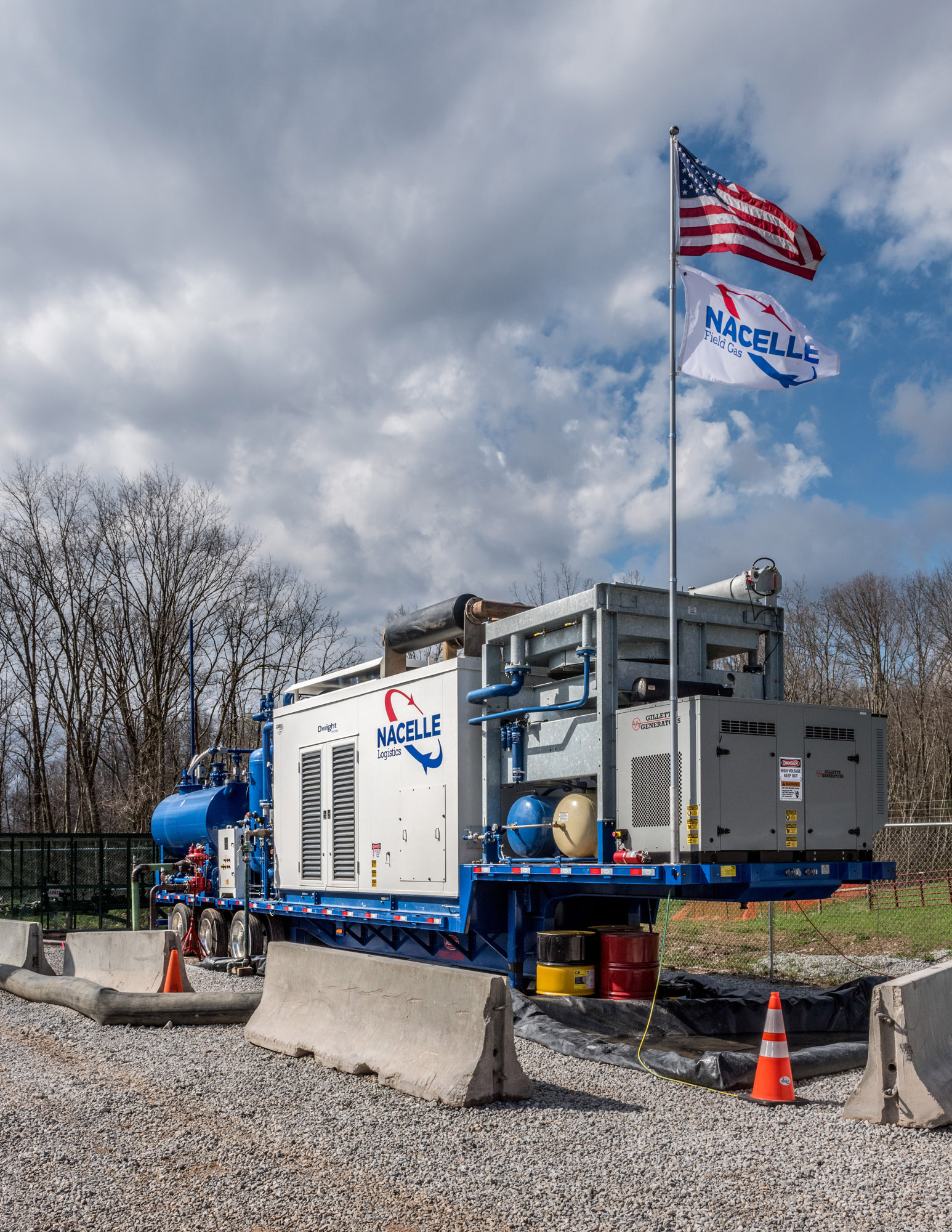 UNIT ENABLES POWERING OF DRILLING, COMPLETIONS EQUIPMENT
UNIT ENABLES POWERING OF DRILLING, COMPLETIONS EQUIPMENT
Nacelle Solutions has successfully released its proprietary mobile DWIGHT field gas conditioning technology. The system enables the use of high-Btu field gas to power high-horsepower equipment used in drilling and completions. Using field gas to replace or displace diesel fuel provides many benefits for operators, including significant reductions in operating costs; lower emissions output; reduced truck traffic in local communities; and improved onsite safety related to the use of diesel fuel, CNG or LNG. Nacelle’s DWIGHT enables the use of high-Btu gas by conditioning source gas onsite to the engine manufacturer’s specifications to maximize engine performance. An enriched gas stream that results as part of the conditioning process is returned to the pipeline, ensuring value is captured downstream. Nacelle’s DWIGHT technology has worked for multiple operators, saving millions of dollars in diesel costs and providing average savings of more than $2,000 per stage on completions jobs in a below-$2/gal diesel price environment. nacellesolutions.com
CT SYSTEM OFFERS ENHANCED LUBRICITY FOR LONGER LATERALS
Newpark’s ResurreCT system is specifically designed to provide critical lubricity for coiled tubing (CT) operations, especially those with long horizontal laterals such as shale stringers. Achieving lateral length requires lubricity to reduce the friction of metal-to-metal contact. Longer lateral lengths also require controlling the torque and drag forces, which determine the number of trips and tool runs and, ultimately, the well cost. The lubricant for the ResurreCT system is designed to address this critical issue in CT operations. DireCT, the effective pipe-on-pipe friction reducer in the ResurreCT system, was evaluated for wear and steady-state coefficient of friction using a Falex Block-on-Ring Test. The lower coefficient of friction properties provided by the proprietary lubricant enhances the CT operations, allowing increased weight on bit and a reduction in the number of trips required for a successful CT operation. Operational and engineering gains provide significant value to the customer. The ResurreCT system is effective in a wide variety of densities and is thermally stable at temperatures greater than 204 C (400 F). newpark.com
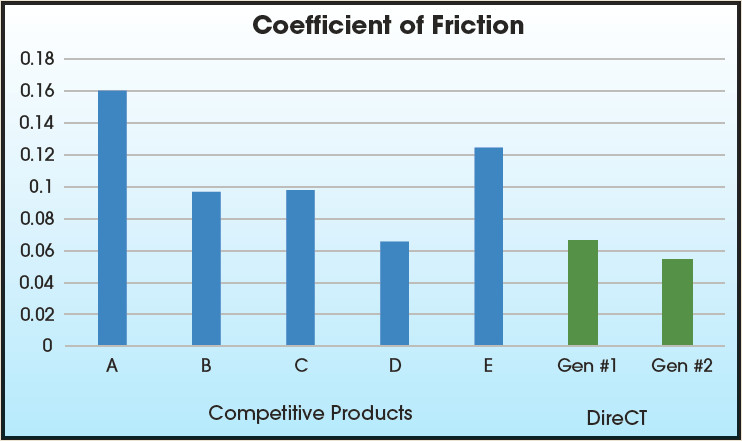
This graph shows the lower coefficient of friction achieved by two Newpark products available for use in the ResurreCT system. (Source: Newpark)
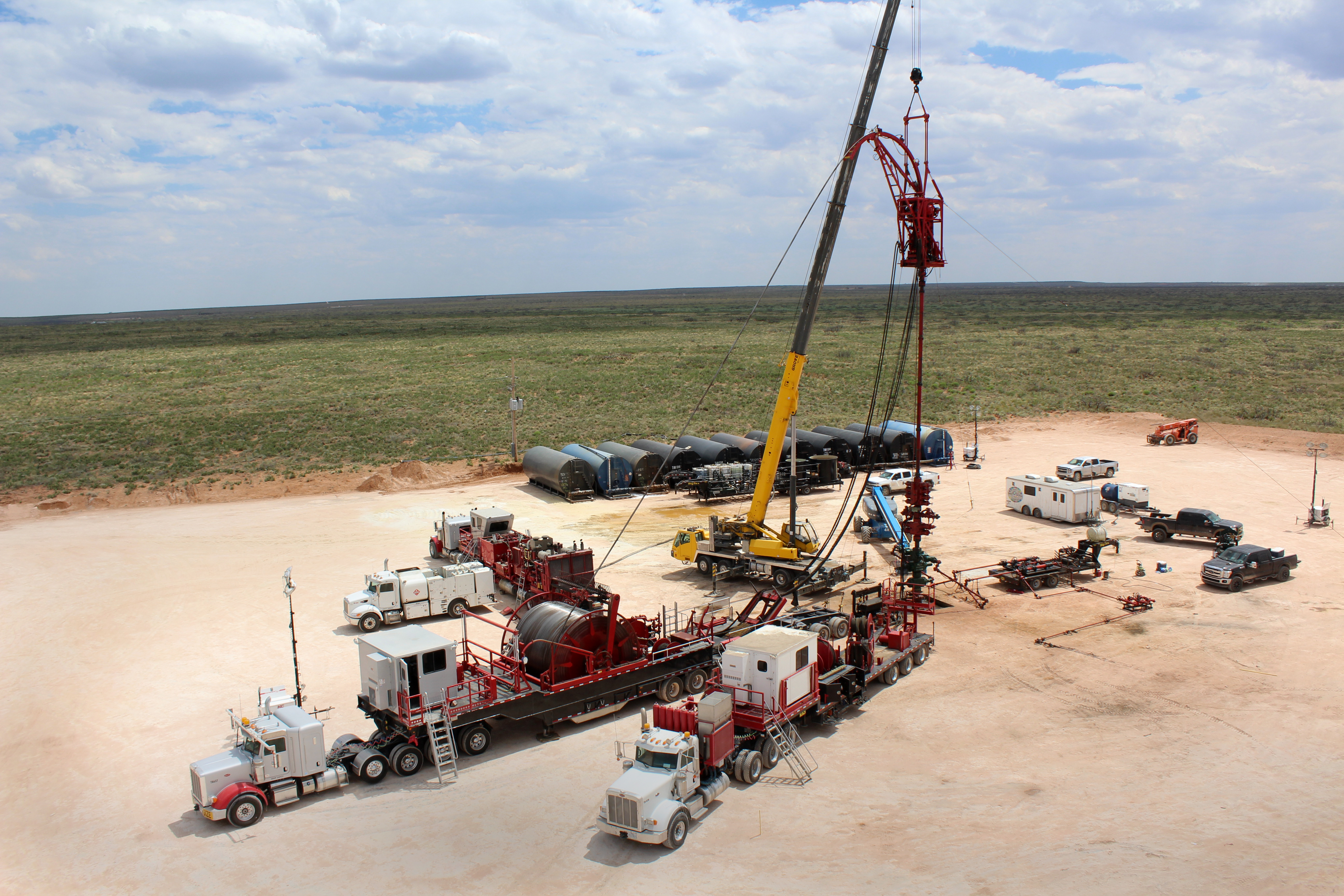 TOOLS ENABLE ENHANCED SHALE INTERVENTION, STIMULATION APPLICATIONS
TOOLS ENABLE ENHANCED SHALE INTERVENTION, STIMULATION APPLICATIONS
National Oilwell Varco (NOV) has released several products that are designed to enable greater performance in shale intervention and stimulation applications. The CTES Condition-Based Monitoring (CBM) System and the Texas Oil Tools Stack Monitor are real-time monitoring systems for intervention and stimulation equipment. The CBM System monitors the health of pumps, bearings, filters and engines as well as hydraulic power and lubrication systems. The Stack Monitor provides real-time data on the entire BOP stack, allowing monitoring of the rams’ positions, latch-and-lock systems and stripper pressures. Early identification of potential failures improves uptime and reduces maintenance costs while ensuring safety and efficiency at the well site. Quality Tubing QT-1400 is the next generation of ultrahigh-strength coiled tubing (CT). With minimum yield strength of 140 kilopounds per square inch, QT-1400 is the strongest CT on the market, according to NOV. With greater resistance to low-cycle fatigue cracking at high pressure, QT-1400 is ideal for shale applications. CT that can withstand harsh downhole environments is critical in increasingly challenging horizontal wells with longer lateral sections, refracturing applications and deepwater operations. nov.com
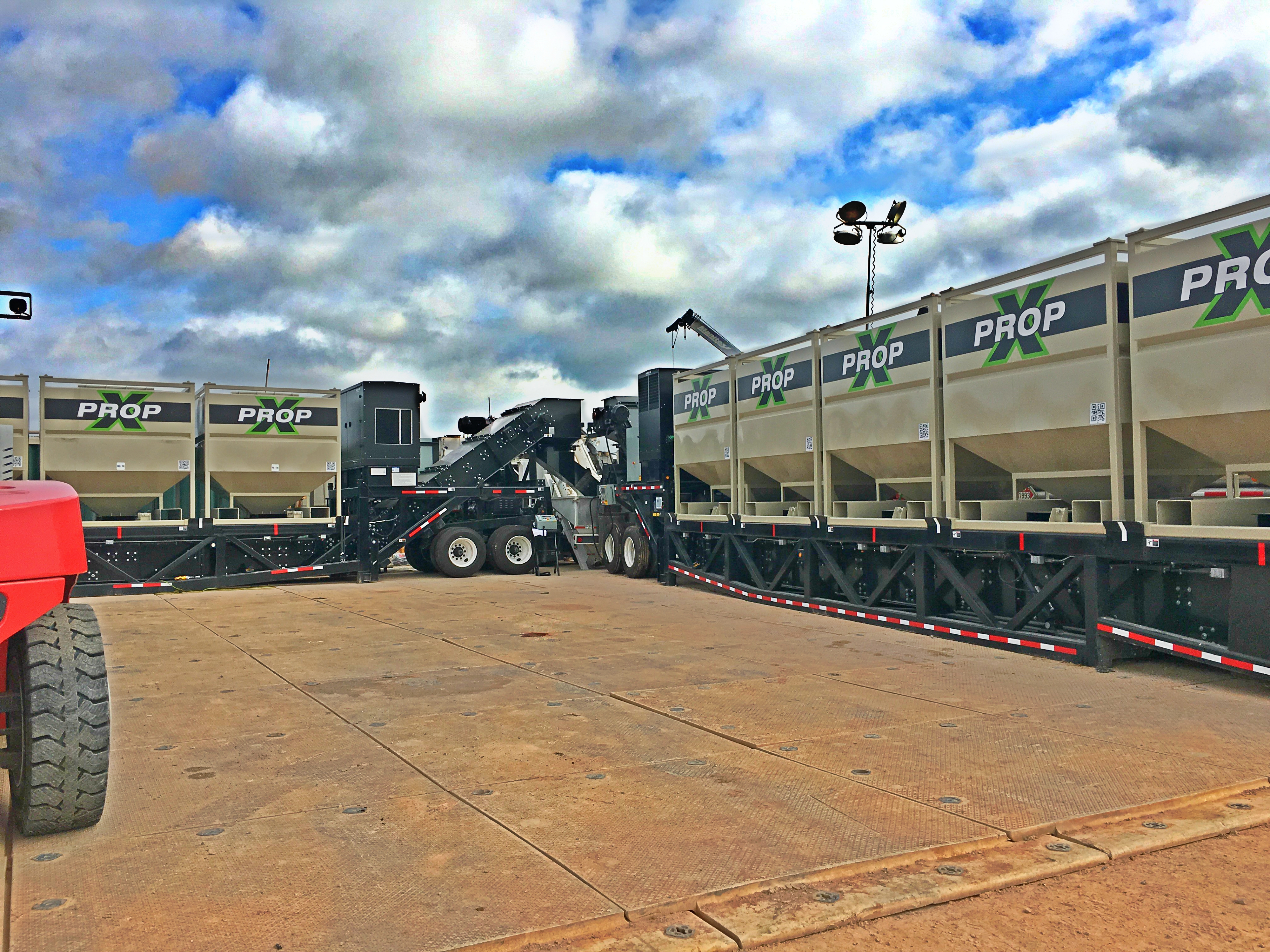 DELIVERY SYSTEM ADDRESSES PROPPANT SHORTAGES
DELIVERY SYSTEM ADDRESSES PROPPANT SHORTAGES
Increasing lateral lengths, stage counts and fracturing sand volume in North American shale plays are creating a shortage of proppants. These factors point to fracturing sand demand of 65 million tons to 80 million tons this year and 90 million tons to 120 million tons in 2018—double historic maximums. Sand production at the mines and sand transportation along the railways will both be tested, but the final pinch point of “last-mile sand logistics” could likely be the determining factor of whether the needed supply reaches the wellhead. PropX, a proppant delivery system provider, has developed an efficient mobile delivery system that has delivered more than 2 billion pounds of proppant during the past six months, including a record 9.3 million pounds delivered by a single fracturing spread in a 24-hr period. Using a gravity feed system to eliminate dust and reduce the noise of fracturing sand blowoff along with the PropBeast conveyor system, PropX allows the hauling of more sand per truckload on conventional flatbeds for fast unloading as well as the ability to prestage proppant on location in areas requiring long hauls over treacherous roads. Silica dust testing indicates that PropX systems meet or beat the expected 2018 Occupational Safety and Health Administration regulations. propx.com
NEW TECHNOLOGY OFFERS COMPLETIONS QUALITY CONTROL
A new concept for an operator’s hydraulic fracturing toolkit validates completions designs with compelling simplicity. IMAGE Frac pressure-based fracture geometry generates hydraulic fracturing maps and fracture growth curves using only a surface pressure gauge in addition to a bridge plug that isolates an offset well’s observation stage. This leads to minimum operational risk and cost. The hydraulic fracture maps and fracture growth curves ensure operators can adjust their completions designs to match a development’s varying geology. By confirming the completions are producing the planned fracture dimensions, operators can work with factory mode consistency to drive increased commercial value of pad development in each unit. This diagnostic tool is supporting well objectives with relevant data in relevant time. Launched in 2016 by Reveal Energy Services, IMAGE Frac technology is field-proven in more than 120 wells across seven U.S. shale basins for numerous major North American oil and gas operators. reveal-energy.com

IMAGE Frac technology analyzes the recorded pressure data and determines the fracture attributes, including length, height, fracture growth rates and fracture asymmetry. (Source: Reveal Energy Services)
![]() HYDRAULIC TOE VALVE ENABLES CASING TESTS AT MAXIMUM PRESSURE
HYDRAULIC TOE VALVE ENABLES CASING TESTS AT MAXIMUM PRESSURE
Rubicon Oilfield International has released its latest toe valve technology with the HydraSTART multistart toe valve (MTV). Hydraulically actuated toe valves are run at the toe of a horizontal well to either initiate pumpdown or act as the first stage after cementation. The HydraSTART MTV enables the operator to test casing at maximum pressure and then open the valve without exceeding the casing test pressure. This ensures the well casing is not damaged after a successful casing test. Current solutions rely on intricate mechanisms requiring multiple moving parts or fluid passing through an orifice, both of which introduce complexity into the system and could affect reliability. The patent-pending design of the MTV has a simple operation that overcomes the limitations and risks associated with the current technology. Activation of the valve is not dependent on or limited by the rating of a rupture disk, further reducing the risk of not opening. The tool provides an additional configuration that allows multiple valves to be run and open at the same time. With multiple valves, operators can perform their casing tests just as with one sleeve, and then upon bleed-off, all valves will open together. Combined with tailored limited entry ports, the tools will mimic a perforation cluster and can act as the first fracture stage. Finally, all toe valves work together as system with the right wiper dart and landing collar. The Rubicon wiper dart and landing collar are designed and proven to provide efficient wiping in the casing through the sleeve and provide a pressure seal for the casing test and valve activation. The HydraSTART MTV has already proven 100% successful in multiple wells. rubicon-oilfield.com
 NEW PROPPANT CONTAINERS ENHANCE SITE SAFETY AND EFFICIENCIES
NEW PROPPANT CONTAINERS ENHANCE SITE SAFETY AND EFFICIENCIES
Getting the most out of shale wells relies on many factors, including the ability to safely, consistently and efficiently receive high volumes of proppant. At many well sites 500 truckloads of proppant are required to arrive within days, gridlocking surface operations. Unloading traditional pneumatic trucks can take up to an hour each, and there are additional hazards in addition to congestion such as dust and noise. SandBox Logistics has developed patent-protected equipment and processes to mitigate wellsite congestion and ensure a safer, cleaner environment. Specialized containers are unloaded in less than five minutes without the noise and dust concerns of pneumatic trucks. “We fill stackable SandBox containers at transload facilities or regional mines,” said Zach Carusona, SandBox vice president of business development. “We then stage 40 to 60 SandBoxes at the well site, where they are placed onto a conveyor system that delivers the proppant directly into the blender hopper.” Dan Mullins, executive vice president of operations and sales at Producers Service Corp., said SandBox Logistics has generated significant benefits at his well site. “The process is safe and efficient, which translates into cost-savings,” he said. “Using SandBox, we eliminate a main bottleneck in the system. We also greatly reduce the risk of silica dust exposure for our crew, which is foremost in our HSE program.” sandboxlogistics.com
 INCREASE RESERVOIR CONTACT WHILE MINIMIZING CAPEX
INCREASE RESERVOIR CONTACT WHILE MINIMIZING CAPEX
As shale development matures and operators seek new ways to improve recovery from limited acreage and declining budgets, multilateral well technology adds an economic lifeline for adding new infill wells while maintaining existing assets. The Schlumberger RapidTieBack TAML 3 or 4 conventional multilateral junction enables selective, repeatable entry and isolation for efficient multistage stimulation in wells with multiple laterals. Its high hanging capacity enables operators to maximize reservoir contact in long horizontal or vertical intervals with minimal location footprint and with greatly reduced capex investment as compared to drilling new wells from the surface. In operation a sealbore connection isolates the selected lateral, enabling efficient plug-and-perf (PNP) multistage operations. Simple and cost-effective, the RapidTieBack multilateral junction is compatible with many completion options, including cemented or uncemented laterals, dissolvable and conventional PNP systems, and hydraulic multistage fracturing. It has no welded components and is fully stackable, with large inner diameter access to both the main and lateral bores. slb.com
 ONLINE WATER-SOURCING DATABASE ALLOWS OPERATORS TO FIND, DISPOSE OF WATER
ONLINE WATER-SOURCING DATABASE ALLOWS OPERATORS TO FIND, DISPOSE OF WATER
Sourcewater.com is an online platform for water sourcing and disposal—a type of eBay for water. During the past five years, horizontal completions have grown from using 100,000 bbl of water per fracture to 500,000 bbl or more. Pad drilling requires millions of barrels in a short time. Historically, most water came from surface use agreements with drilling parcel owners. But now there is rarely enough water on any one parcel to supply completions. Pads require multiple redundant water sources—a huge planning and logistical challenge for completions. With water consumption setting new records, there is not enough from traditional sources to meet industry needs. Sourcewater.com enables operators to post their upcoming water needs anonymously, then receive competing water source and disposal bids from every landowner, operator and service company within range, including water type, water quality, location, price, logistics cost, volume and dates available. Sourcewater.com’s reverse auction drives down total cost while revealing all possible supplies, even nontraditional sources like produced water and flowback, treated water, and excess operator water. Sourcewater.com reduces completions engineering time managing water, ensures the water supply chain and reduces water and logistics cost. The system also enables operators to market excess water capacity to improve their infrastructure return on investment. sourcewater.com
 SOLID OST ENHANCES PRODUCTION ANALYSIS
SOLID OST ENHANCES PRODUCTION ANALYSIS
The utility of oil-soluble tracers (OST) in production analysis is based on the assumption that chemical tracer recovery in produced oil accurately reflects downhole oil production. How closely this holds true is a function of how closely OST recovery is proportional to actual oil production. Any fluid pressure pumped into a formation can be squeezed back out of the formation by in situ pressure and can result in false-positive oil production readings. Historical data recovery from liquid OSTs has been relatively short-term. This is because injected OST liquid volumes are low relative to total injected fracture fluid volumes and consequently quickly play out. This has been a well-known and generally accepted industry norm for decades, with no known practical alternative. To address these limitations, 34 solid OST products are now available to the completion and refracturing market. These solid particulate OSTs are injected into the blender tub along with the proppant and carried out into the formation during hydraulic fracturing. These particulates then remain locked deeply in situ in the fracture pack, thereby eliminating the effect of formation pressure squeezing the OSTs back out of the formation as the fracture pressure wave subsides. The particulate OST only releases its chemical tracer signature when movable oil comes in contact with the embedded particulate. This results in longer term datasets, with some instances exceeding two years of tracer recovery. spectrumtracer.com
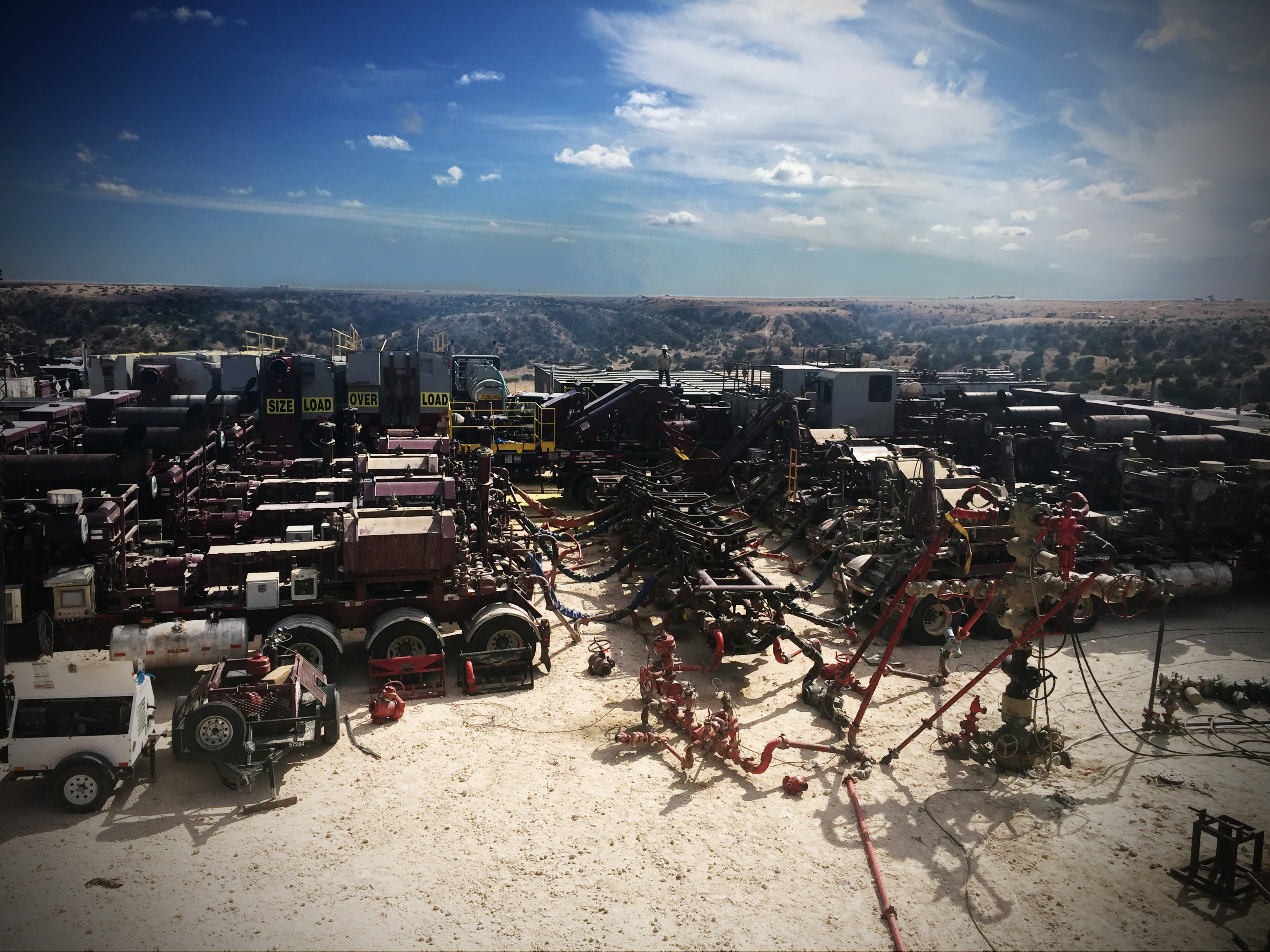 DIVERTER SYSTEM ALLOWS OPERATORS TO MAINTAIN MORE CONSISTENT STIMULATION VOLUME
DIVERTER SYSTEM ALLOWS OPERATORS TO MAINTAIN MORE CONSISTENT STIMULATION VOLUME
Thru Tubing Solutions’ SlicFrac diverter system is the most economical and adaptable diverter on the market, according to the company. SlicFrac Perf PODs are an interwellbore diverter designed to seal both circular and irregular-shaped holes, providing a solution for new completions and refracturing operations. SlicFrac Perf PODs seal inside the perforation, eliminating any formation damage or residual fracture obstructions. SlicFrac diverting technology allows operators to reduce the number of bridge plugs within a wellbore while maintaining the advantages of closer stage spacing and additional clusters. The risk of a preset plug can be drastically reduced along with pumpdown time, completion cost and resources associated with the corresponding wireline runs and subsequent millout work. Applying SlicFrac between bridge plugs allows the operator to achieve maximum cluster efficiency while stimulating the entire stage without leaving orphan clusters behind. SlicFrac Perf PODs are available in both degradable and millable materials optimized for each wellbore based on bottomhole temperature and pressure ratings. Deployed from surface, Perf PODs are launched during the fracture to divert flow, allowing subsequent breakdown and perforation isolation. thrutubing.com
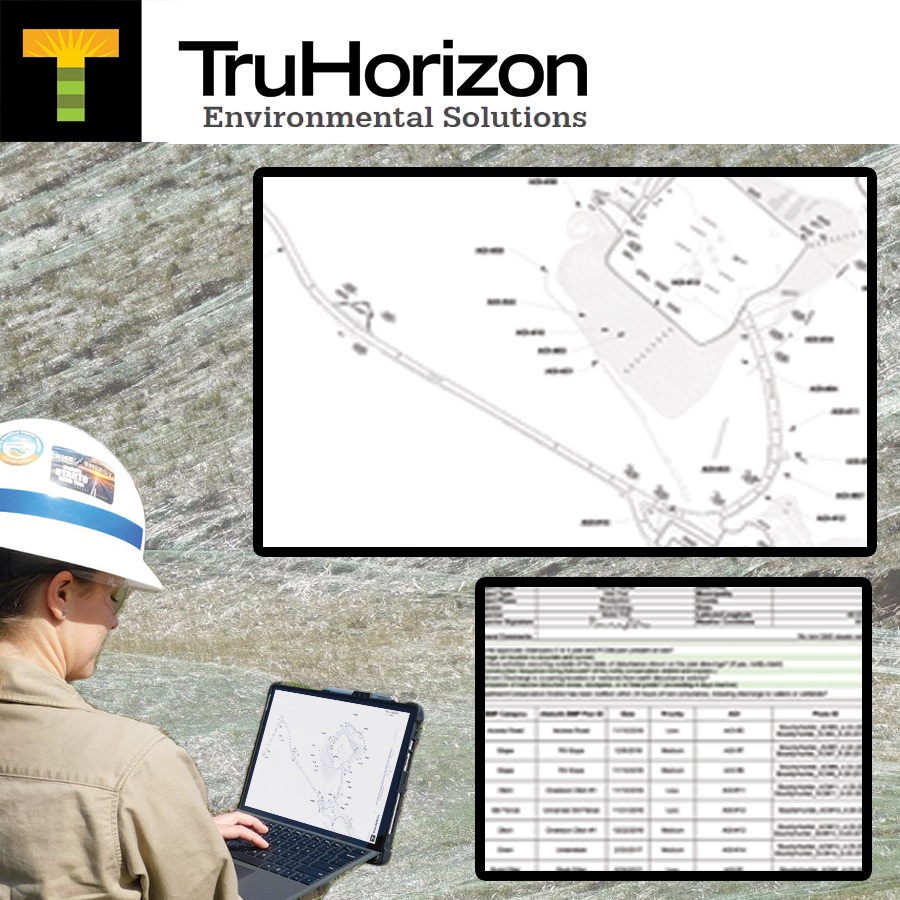 DATA SYSTEM ENHANCES DOCUMENT MANAGEMENT FOR OPERATORS
DATA SYSTEM ENHANCES DOCUMENT MANAGEMENT FOR OPERATORS
Environmental compliance and documentation can present numerous management challenges for oil and gas operators faced with multiple permits required at the work site and inefficient, paper-based data storage. Most operators use some combination of handwritten scanned paper reports and emailed spreadsheets from the field. These documents are typically delivered to the responsible person and stored in an email directory or a physical paper file. Every operator has valuable information it is not using, and audit support often is chaotic. TruHorizon’s new environmental compliance data management application, TruData, is a central digital repository for environmental and regulatory data. Incorporating inspection, monitoring and tracking, TruHorizon’s application has robust daily, weekly and monthly summary reporting supported by daily detailed inspection reports. The environmental compliance data management application easily and effectively verifies the compliance status of any location or geographic area. TruData can provide custom data collection and reporting to meet the unique compliance and business needs of the operator. Improved confidence in compliance, streamlined operations and reduced cost of repairs and maintenance results from using the data already being collected. truhorizon.com
 PROPPANT HELPS REDUCE FLOWBACK AND IMPROVES CONDUCTIVITY
PROPPANT HELPS REDUCE FLOWBACK AND IMPROVES CONDUCTIVITY
For pressure pumping and E&P companies working in the Permian Basin and other shale plays, one goal is to get more out of the well while putting less into it in terms of time, money and potentially hazardous chemicals. In low-temperature reservoirs, however, liquid chemical activators are typically added to bond resin-coated sand together, a process that increases expense and risk. U.S. Silica’s new proppant, InnoProp PLT, was created to eliminate the need for activators as well as the cost, safety and environmental concerns that accompany them. The formaldehyde-free resin-coated proppant outperforms all competitive products designed for low-temperature reservoirs. Because of its bond strength, InnoProp PLT can significantly reduce or prevent flowback at downhole temperatures as low as 21 C (70 F) without requiring an activator. In addition, independent tests indicate InnoProp PLT delivers best-in-class crush resistance and hydraulic conductivity. Crush resistance keeps fractures from closing and prevents fines that can reduce flow. Superior conductivity means the proppant brings hydrocarbons to the surface faster for better return on investment and lower overall cost. To ensure consistent quality, InnoProp PLT’s substrate is U.S. Silica White sand. The product is available in multiple mesh sizes and is compatible with all current fluid systems. ussilica.com
 PDC BIT OFFERS INCREASED LONGEVITY AND REPAIRABILITY
PDC BIT OFFERS INCREASED LONGEVITY AND REPAIRABILITY
With shale well fracturing plug spacing getting tighter and more plugs to drill in a lateral, Varel Oil & Gas Drill Bits has developed the SlipStream polycrystalline diamond compact (PDC) bit, specially designed for fracturing plug drilling. This PDC technology builds on the successful philosophy of the SlipStream RC bit to produce small cuttings, minimal torque, bit repairability, bit longevity and efficient milling speeds of five to eight minutes per plug. Three test runs in the Bakken Field have drilled out 45, 56 and 59 fracturing plugs, respectively, all drilling at less than six minutes per plug. Current bit runs in the Rockies and West Texas have produced cutting sizes similar to the SlipStream RC. The traditional full-face cutting structure requires minimal torque to turn the bit. Additionally, an integrated cutting structure has been designed on the gauge, ensuring the metal slips are drilled out, full diameter is maintained throughout the length of the well, bit stability is sustained and cuttings are properly evacuated. Bit reparability is enhanced with Varel’s design standards, which lead to better dulls and longer bit life. varelintl.com
 GAS TURBINES OFFER FUEL FLEXIBILITY, EXTENDED OPERATING LIFE
GAS TURBINES OFFER FUEL FLEXIBILITY, EXTENDED OPERATING LIFE
Vericor’s TF50F and TF40F gas turbines designed for oilfield and other tough-environment portable applications are compact, powerful (5,000 hp) and light (2,000 lb). The turbines feature hydraulic fracturing capabilities, power for drilling rigs, mobile electric power, gas compression stations and cogeneration for oil and gas processing plants. The turbines also offer reduced weight and size as well as fuel flexibility. The engines can run on natural gas or liquid fuel and switch between the two fuels during operation if needed. In comparison to current diesel engines, Vericor’s gas turbines are lighter and smaller, offering cost savings in logistics and diesel transportation. The systems also minimize disturbances, reduce the environmental impact through less emissions, lower noise and offer a smaller carbon footprint. In the case of hydraulic fracturing such a scenario can represent a doubling of the power of each fracturing unit, leading to additional savings of reduced personnel needed to operate the equipment onsite. Vericor’s gas turbines also could be used with field flared gas, transforming the gas into electrical energy and heat. The engines often exceed 100,000 hours of operation, with a first major overhaul occurring at 30,000 hours, an advantage in terms of downtime and maintenance cost over diesel engines. vericor.com
Recommended Reading
GOP House Members Lobby for Canceled New York Pipeline Project
2024-12-06 - Republican representatives penned a letter to New York Governor Hochul, expressing criticism of the opposition to the Northern Access Pipeline.
Pickering Prognosticates 2025 Political Winds and Shale M&A
2025-01-14 - For oil and gas, big M&A deals will probably encounter less resistance, tariffs could be a threat and the industry will likely shrug off “drill, baby, drill” entreaties.
NextDecade Advances FID Talks for Rio Grande Train 4
2024-11-08 - NextDecade also reported updates to Phase 1 development , which is currently underway for the facility’s Trains 1, 2 and 3.
Electrification of Permian Faces a Problem: Not Enough Shock for the System
2024-11-21 - Permian Basin producers may have to wait years for Texas utilities to grow the grid.
Analysts: DOE’s LNG Study Will Result in Few Policy Changes
2024-12-18 - However, the Department of Energy’s most recent report will likely be used in lawsuits against ongoing and future LNG export facilities.
Comments
Add new comment
This conversation is moderated according to Hart Energy community rules. Please read the rules before joining the discussion. If you’re experiencing any technical problems, please contact our customer care team.





